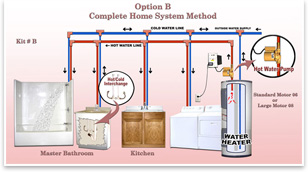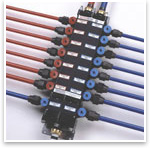Best Practices
Dealing with the Wait for Hot Water
by Alex Wilson
excerpted from Your Green Home
 Summary: In the typical American home, 10,000 gallons of water per year are wasted as we wait for hot water to come through the tap. There are design solutions. Continuous-circulation systems for hot water—commonly used in hotels—keep hot water seconds away from every tap in the house all the time. On-demand hot-water circulation systems bring hot water to a tap just before use while returning unused cooled water to the water heater. Small-diameter hot-water tubing offers a third approach. Summary: In the typical American home, 10,000 gallons of water per year are wasted as we wait for hot water to come through the tap. There are design solutions. Continuous-circulation systems for hot water—commonly used in hotels—keep hot water seconds away from every tap in the house all the time. On-demand hot-water circulation systems bring hot water to a tap just before use while returning unused cooled water to the water heater. Small-diameter hot-water tubing offers a third approach.
How long it takes hot water to reach a bathroom or kitchen fixture depends on a) how far that point of use is from the water heater, b) how quickly the water is flowing through the hot-water pipes (the flow rate of the fixture drawing water), and c) the diameter of the hot-water pipes.
With larger-diameter pipes (3/4-inch is now standard in much of the country), low-flow faucets and showerheads, and a sprawling house, the wait for hot water can easily be three minutes or longer. The waste can be even greater if a homeowner turns on the water and then leaves the room to do something else while waiting for hot water; if he or she gets distracted and hot water runs for a few minutes, significant quantities of both water and energy are wasted.
 Continuous-circulation systems Continuous-circulation systems
To solve the water-waste problem, continuous-circulation systems are being installed in many homes. These systems, commonly used in hotels, circulate hot water around the building continuously, so that hot water is always a few seconds away; you don’t waste water waiting for hot water to reach your sink or shower. The problem with this solution is that the hot-water pipes end up acting like round-the-clock radiators that waste water-heating energy year-round and contribute to a home’s air conditioning load in the summer months.
On-demand circulation systems
Much better is an on-demand hot-water circulation system. At least two manufacturers produce a user-activated pump that very quickly brings hot water to the point of use and returns the cooled-off water that had been sitting in the hot-water pipes back to the water heater. The pump can be activated manually with a button or wired to an occupancy sensor to turn on automatically when someone enters the room. The pump turns off when hot water reaches a sensor at the point of use. These systems are very different from continuous-circulation systems in that the hot water is only brought to the bathroom or kitchen when needed. You have to wait a little longer, but no water is wasted. In new houses, a separate return line back to the water heater is installed. With existing houses, the cold water supply line is used as the return.
 Small-diameter tubing Small-diameter tubing
Another solution to the problem of wasting water while waiting for
hot water is to install small-diameter tubing for the hot-water
lines. In some regions, these “home-run” plumbing systems have
become quite popular. They use small-diameter cross-linked polyethylene
(PEX) tubing, with each fixture being served by its own supply
tubing sized to the fixture’s flow rate, typically 3/8 or
1/2 inch, but larger for a bathtub. The individual tubes extend
off a central manifold near the water heater. Much less water is
wasted because less water is held in the tubing, and hot water
reaches the point of use quickly.
Copyright 2006 by Alex Wilson
Reprinted with permission.
|


 Summary:
Summary:
 Small-diameter tubing
Small-diameter tubing